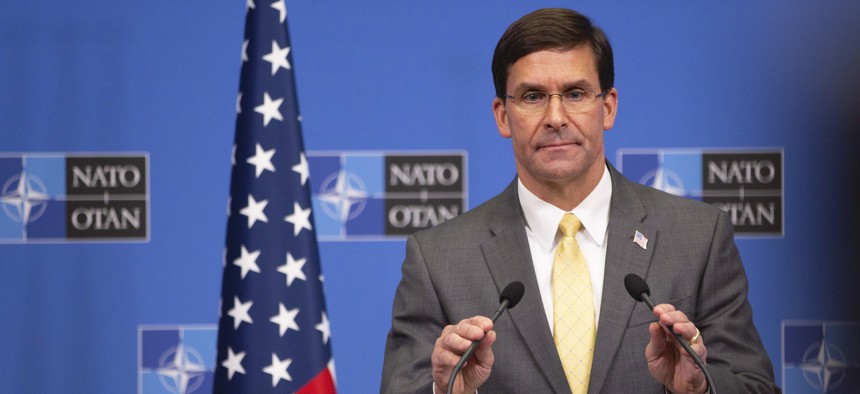
U.S. Secretary of Defense Mark Esper speaks during a media conference after a meeting of NATO defense ministers at NATO headquarters in Brussels, Friday, Oct. 25, 2019. AP / Virginia Mayo
US Troops, Armor Will ‘Secure’ Oil Fields in Syria, Says SecDef in New Reversal
The U.S. might also maintain “one of our two airfields that are there,” said America’s envoy to Syria to lawmakers.
The United States will leave troops in eastern Syria to guard Kurdish-controlled oil fields from the Islamic State, Defense Secretary Mark Esper said Friday.
“We are considering how we might reposition forces in the area in order to make sure that we secure the oil fields,” Esper said during a press conference at the NATO headquarters in Brussels. The United States is “taking some actions to strengthen our position at Deir ez Zour” to deny ISIS access to the fields, Esper said. The deployment “will include some mechanized forces,” he said, but declined to provide specifics.
The broader withdrawal will continue, he said.
The announcement is the latest head-spinning turn in President Trump’s unpredictable Syria policy — and the second time in less than a year that he has reversed course after announcing a complete withdrawal from the country. In December, he announced that the roughly 2,000 troops in Syria would be coming home; nine months later, about 1,000 still remained there. The administration announced the latest complete withdrawal this month and have been moving forces out of northeastern Syria over the past two weeks, despite concerns from Pentagon and State Department officials that the withdrawal would allow ISIS to rise again.
Related: How to Protect America After the Syria Withdrawal
Related: 10 Hard Realities of America’s Next Syria Policy
Related: Trump Declares Victory in Syria, Claims Credit for It All
U.S. troops will now remain in the eastern Syrian province of Deir al-Zour, Esper said, where the United States has kept a base.
“We are reinforcing that position,” the secretary said. “The mission in Syria remains what the mission in Syria began with: it’s always been about defeating the ISIS coalition. That is the core mission.”
The top U.S. envoy for Syria, James Jeffrey, told lawmakers on Capitol Hill Wednesday that the United States might also maintain “one of our two airfields that are there.”
The option of sending tanks to guard the oil fields was first reported by Newsweek.
Trump has publicly focused on the oil fields as both the solution and justification for U.S. troop movements over the past several weeks. “We will NEVER let a reconstituted ISIS have those fields!” he tweeted Thursday. “Perhaps it is time for the Kurds to start heading to the Oil Region!”
“When these pundit fools who have called the Middle East wrong for 20 years ask what we are getting out of the deal, I simply say, THE OIL, AND WE ARE BRINGING OUR SOLDIERS BACK HOME, ISIS SECURED!” he tweeted Friday morning.
Trump has faced vocal criticism even from close allies on Capitol Hill over the withdrawal.
In a phone call with Turkish President Recep Tayyip Erdogan on Oct. 6, Trump responded to the Turkish president’s threat of an imminent attack on the U.S.-allied Kurdish fighters — who did the bulk of the fighting against ISIS alongside the United States — by saying that he would clear a small contingent U.S. soldiers from a narrow border zone. Critics say that Trump gave Turkey a de facto “green light” to attack the United States’ Kurdish allies.
Within three days of the phone call with Trump, Erdogan had launched the first airstrikes. Days later, Trump announced a full withdrawal of the remaining 1,000 troops from Syria, leaving behind the Syrian Kurdish and Arab fighters who for four years have been battling ISIS with U.S. direction, and fending off Syrian President Bashar al-Assad’s forces.
Erdogan has repeatedly threatened to attack the U.S.-allied Syrian Democratic Forces, which was built in part using fighters from the militia arm of the PKK, a Kurdish separatist group in Turkey that the State Department and Ankara consider to be terrorists. But he had never followed through on those threats until Oct. 9, when Turkish forces began launching air and artillery strikes into northeastern Syria.
Trump’s apparently snap decision upended years of U.S. policy in Syria across successive administrations, and officials have been scrambling since to develop a new strategy that would prevent ISIS’ resurgence of ISIS without U.S. troops in Syria. Esper initially said that the withdrawn troops would continue to fight ISIS from neighboring Iraq, but the Iraqi government has since told the United States that its soldiers arriving from Syria must leave within four weeks.
The new focus on Syria’s energy assets raises questions about what authority the military would be operating under — and highlights the uncertainties associated with this drastically new strategy.
“Esper says we are sending armored vehicles to defend the oil fields, not just special forces. This may be the first time we’ve deployed anything other than special forces to Syria. Tanks are obviously less nimble than special forces, so they are more at risk to enemy forces,” tweeted Sen. Brian Schatz, D-Hawaii.
It is also unclear whether the Kurdish fighters who currently control the oil fields will welcome the deployment. The head of the Syrian Kurds’ political party, the Syrian Democratic Council, suggested as much in an interview with Foreign Policy this week.
“If the U.S. presence in the area is not going to benefit us when it comes to stability, security, and [stopping] the genocide and ethnic cleansing, they won’t be welcomed,” said Ilham Ahmed, the president of executive committee of the SDC.
Trump’s call for the Kurds to “start heading to the Oil Region” was met with swift criticism from former officials.
“The President of the United States of America appears to be calling for a mass migration of Kurds to the desert where they can resettle atop a tiny oil field,” tweeted Brett McGurk, the former top envoy to Syria who resigned in protest following Trump’s December withdrawal announcement. “Shocking ignorance of history, geography, law, American values, human decency, and honor.”




